Outboard motors for PVC boats: what are they and how to choose?

After purchasing a simple PVC boat, happy owners begin to think about installing a motor on their vehicle, since there is not always a desire to row relatively long distances. To date, most models of inflatable boats have the ability to install an engine. We will analyze in the article which motors are desirable for installation on PVC boats, their types and features.
Peculiarities
To date, outboard motors for PVC inflatable boats are manufactured according to the scheme proposed by Ol Evindur in 1906. In this diagram, all nodes are located vertically.

One of the features of the device of such engines is the presence or absence of a reverse and a clutch:
- for motors up to 5 hp. With. most often the gearbox does not have a reverse and clutch;
- on engines from 5 to 12 liters. With. a clutch is mandatory, and the reverse mechanism may be absent;
- on engines over 12 hp. With. the presence of a reverse and clutch is mandatory.

Most often, the reverse and clutch are combined into one unit, called the reverse clutch.

The propeller is usually connected to the gearbox shaft through a unit with limited strength, which acts as a kind of fuse. Thanks to him, in the event of a screw hitting an obstacle, serious damage will not occur. After a break in this element, it will have to be replaced with a new one, such a procedure is simple and inexpensive. As such a fuse, as a rule, the middle key or middle pin acts.
The main advantages of the outboard motor are its small size, which does not occupy the useful space of the boat itself, ease of removal and installation, and light weight.

Previously, 2-stroke outboard motors were very popular, which were chosen for their unpretentiousness, high power density, simplicity of design and low weight. Gradually, their shortcomings, as 4-stroke engines improved, pushed 2-stroke engines into the background. Due to their efficiency, high resource, ease of use, they are of interest to consumers and the desire to switch to 4-stroke technology.
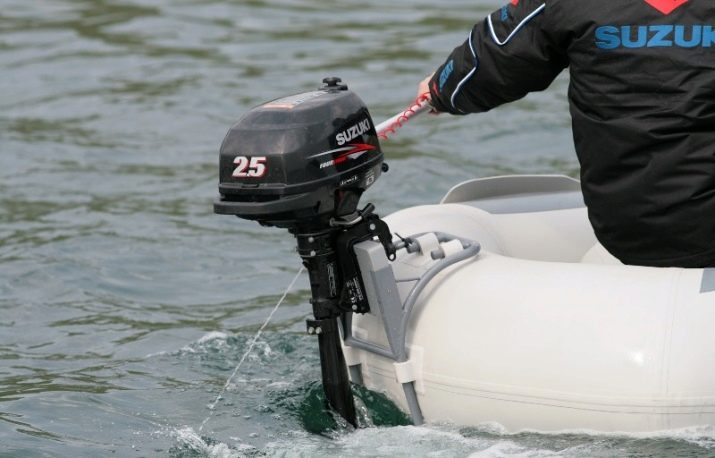
Varieties
There are many options and varieties of outboard motors. Consider their most popular types.
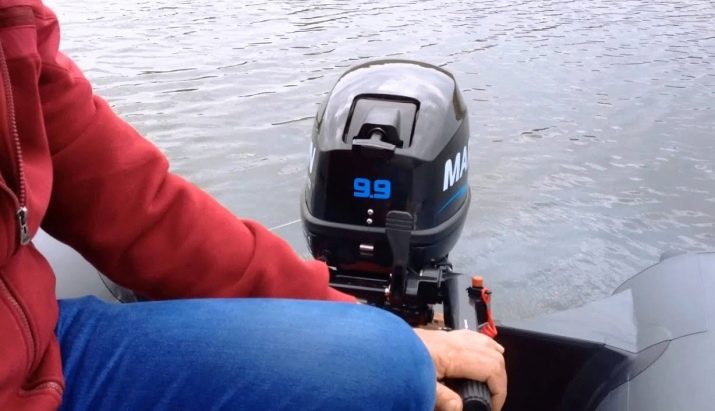
Screw internal combustion engine
Probably the most popular and common engine on any boat. It consists of the internal combustion engine itself and a gearbox that transmits torque to the propeller.
These engines are divided into 2 types:
- 2-stroke;
- 4 stroke.
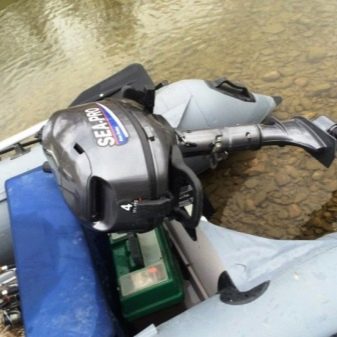

Without going into a lot of technical details of these engines, the most important thing to know before buying an outboard motor is that a 4-stroke engine is fueled by regular gasoline, and a 2-stroke engine is fueled by gasoline mixed with a special engine. oil. It has the usual manual start, and the fuel is supplied through a hose from an external gas tank located in the boat and occupying some space in it.
electric motor
High environmental requirements and the ban on the use of internal combustion engines in some water bodies have led to the need for the development of electric motors powered by batteries. These engines can be attributed to a new species that is just starting to gain its popularity.

The electric motor has a number of advantages over its internal combustion competitors, namely:
- very quiet operation of the engine, which will allow you to sneak up on the prey as close as possible without frightening it, and also allows the owner of such a motor to listen to nature and splashes of water, and not the roar of the engine;
- no harmful emissions, which will protect the reservoir;
- maintaining a stable speed during trolling fishing, on rivers with a weak current or lakes, this will allow spinners to explore places of interest to them;
- low weight will allow you to move and install the motors on a small boat with a low load capacity alone;
- great maneuverability will allow you to go where you have to work with oars;
- there is no need for the cost of maintenance and conservation of the engine for the winter period;
- compact dimensions;
- lack of operating costs (oils, fuel, candles);
- low cost of the kit, sometimes the difference can be 50%.

But it won't be without drawbacks:
- it will not be possible to accelerate more than 10 km / h;
- inability to move on fast-flowing rivers, with strong winds;
- Not suitable for long distance hikes
- to charge a dead battery, an electrical network is required;
- the power supply weighs 2-3 times more than the motor itself and takes up space in the boat.
The described engines are used on small boats for trips on lakes and in places without a current, you can sometimes see them in the role of an auxiliary engine.

Water jets
Most of the water motor travelers and fishermen who have mastered the shallow rivers of Russia use small boats with outboard boat motors equipped with a jet nozzle, instead of the propeller gearbox that is familiar to everyone. An important feature of the jet nozzle is the need for a powerful motor from 10 hp. With. Jet engines are indispensable in shallow water, where the use of a conventional screw device is impossible.

Manufacturer rating
In the field of water transport, it is generally accepted that the best manufacturers of engines for boats are These are Japanese and American companies. Engines from well-known manufacturers are reliable and last a very long time, and they also have excellent performance and do not experience problems with spare parts for repair and maintenance. Good motors have a high price tag, so cheaper Chinese options are increasingly appearing on the market. Reviews about them can be very different depending on the manufacturer.
Motors of the following brands are suitable for PVC inflatable boats:
- Honda;
- Yamaha;
- Suzuki
- tohatsu;
- Hidea;
- Mercury;
- Parsun;
- HDX.
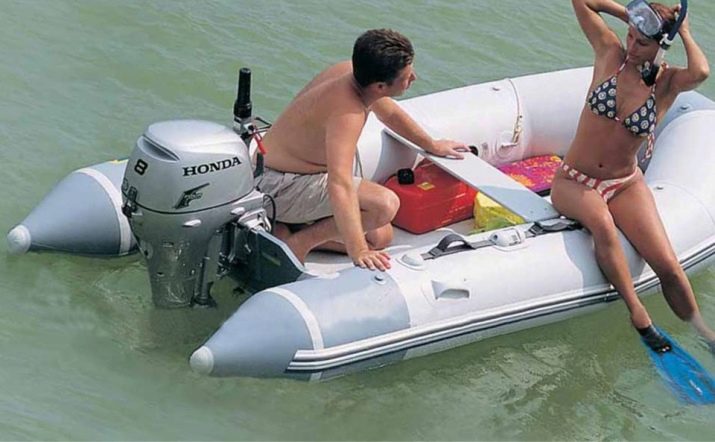
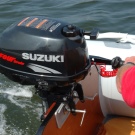
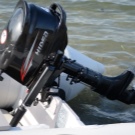



How to choose?
Speaking of rubber and PVC boats, it is necessary to choose a motor for them more carefully than for "hard" boats. An important factor when choosing a power unit will be the technical specifications indicated in the passport for the boat itself, namely:
- the presence of a place for mounting the engine (transom);
- the maximum allowable power of the engine;
- boat carrying capacity.
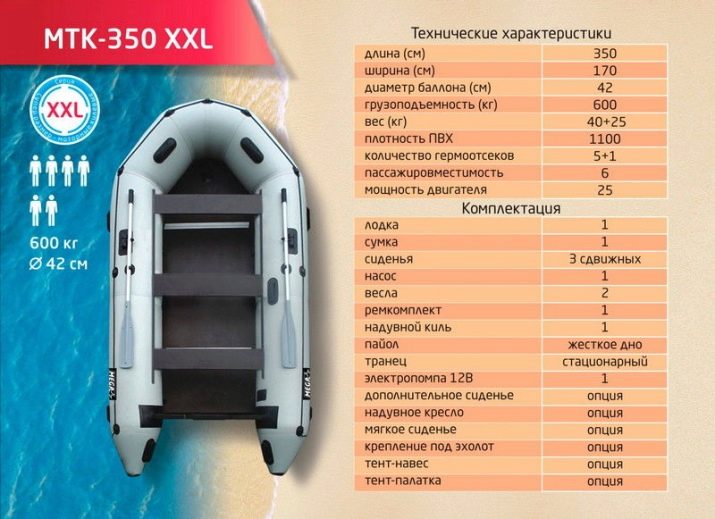
This is necessary for the following reasons:
- by installing the power unit on the boat, we increase the weight of the entire structure, thereby reducing the weight of the transported cargo;
- if the ship does not have its own transom, it will have to be purchased separately, and this is extra weight and an additional power limitation, since only the weakest motors are used with mounted transoms;
- it is impossible to install on a boat gasoline and electric engines of greater power than that allowed by the passport, since this can lead to sad consequences from a lack of power to move a loaded vessel with a weak engine to a coup with excess power.
You need to approach the issue of buying a motor for your boat thoroughly, understanding the main thing - there is no ideal motor that fits all conceivable needs. Each of the presented engines is designed for specific purposes and operating conditions and the terrain on which it will be used.

We must not forget about the dimensions and carrying capacity of the boat for which this motor is purchased - the motor must match the vessel. Consultants in specialized stores will help you choose the engine you need based on the parameters of the vessel. For consultations, it is better to choose well-known outlets with world brands, this is due to the fact that only highly qualified specialists work there.


Speed and power should have a small reserve in case of towing another boat, moving through the water in strong winds and in strong currents. There shouldn't be too much power either.
Buying an engine for a long time, it is better to choose a unit from a well-known manufacturer with a worldwide reputation, in this case you will receive a longer warranty (up to 5 years), a large number of service centers.
How to install?
Installing the motor on the boat will not take much effort and time. Small units can be installed independently without assistants. The instruction manual for the motor, which comes with the unit itself, will help you correctly install the engine.
It is necessary to install the engine strictly in the middle of the transom. Mount the motor and firmly tighten the fixing winglets on the unit bracket. Next, connect the fuel hose and secure it tightly with a clamp. The use of leaky and ruined hoses is unacceptable.
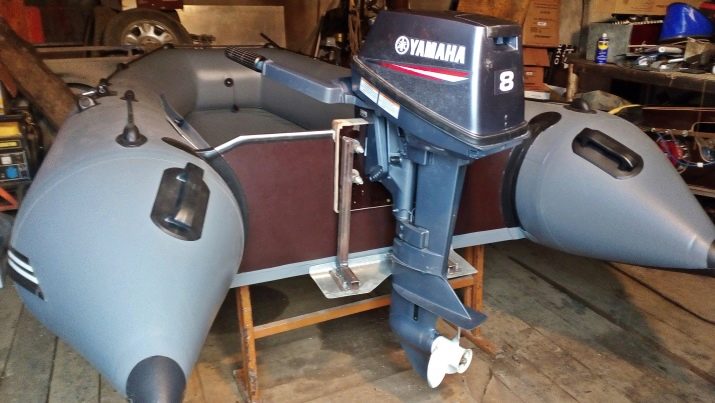
There are holes in the motor mounting bracket that are fixed with a pin - this is necessary to adjust the angle of inclination of the device relative to the boat. If you install the motor at too high an angle (over 15 degrees), then the bow of the boat will rise a lot, which will affect the handling of the boat for the worse.

Installing the motor at a negative angle will lower the bow of the boat, resulting in loss of power and reduced handling.
How to choose the right outboard motor, see the following video.




























